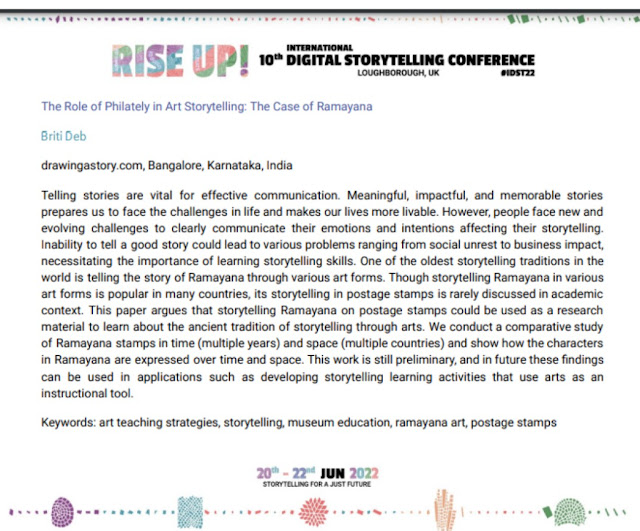Megaliths on the Air MOTA is a proposed radio sport that encourages visits to megalithic sites, shortwave listening, and research and documentation of signal strength. I am pleased to have received the Emerald Award in the British Thematic Association’s 4th Virtual One-Page Competition.
A Blog on Heritage Conservation
h
03 July 2025
01 April 2024
Article: Are We Alone?
I'm happy to announce that my article exploring the possibility of extraterrestrial life beyond Earth, as depicted in the folklores of various cultures, has been published in the April 2024 edition of the Stamp Lover Journal. I hope you enjoy reading it!
06 February 2023
Exhibition: Rediscovering Kolkata through Old Trade and Trade Routes of Bengal
As part of the 17th International History and Heritage Exhibition at the Sabarna Museum in Kolkata, I curated a fascinating philatelic exhibition centered around the theme "Rediscovering Kolkata through Old Trade and Trade Routes of Bengal." The exhibit offered a unique perspective on the city's rich history and cultural heritage, showcasing a range of rare and historic postage stamps that highlighted the significance of trade in the region.
I am excited to offer you a glimpse of this exhibition, which captured the essence of Kolkata's past and its role in shaping the culture and commerce of ancient Bengal.
24 July 2022
Article: The Role of Philately in Art Storytelling: The Case of Ramayana
I am thrilled to announce that my article titled The Role of Philately in Art Storytelling: The Case of Ramayana has been published in the prestigious 10th International Digital Storytelling Conference at Loughborough University, UK. This article offers a unique perspective on the use of philately in art storytelling, specifically in the context of the epic tale of Ramayana.
Through this research, I explored how postage stamps can serve as a powerful tool for conveying cultural heritage and storytelling, offering a fresh perspective on the traditional methods of art storytelling. I look forward to continuing to explore the intersections of philately and storytelling in the future.
This article also received the Bronze Award in the philatelic publication category at the 13th State Level Philatelic Exhibition KARNAPEX 2024 held in Bangalore, India.
29 May 2022
Article: Fascinating Stories of the World
06 January 2021
Article: Ancient Paintings and their Incredible Stories
01 November 2014
Workshop: Ramayana Painting
08 September 2014
Exhibition: Inspiring India
02 August 2014
Online Exhibition: Storytelling Ramayana through Philately
The tradition of Ramayana storytelling has been preserved through art forms such as paintings and other cultural heritages such as Pattachitra, Mysore, Cheriyal, Madhubani, Thangka, Chitrakathi, Phad, Murals, Kamasan, to name a few. Ramayana feature stories about peace and war, to show the importance of moral values, bravery, and sacrifice.
| Ramayana Painting Genre | Characteristics |
| Madhubani Mithila | Wall art, simple geometrical patterns, symbolic images, drawing tools were fingers, twigs, brushes, nib-pens, matchsticks, natural dyes and pigments |
| Chitrakathi | Narrative scroll, used handmade paper, brush and natural colors, accompanied by musical instruments |
| Pattachitra | Narrative scroll, accompanied by songs, free-flowing and bold outlines, natural colors like white, red, yellow, and black with decorative borders |
| Phad Kavad | Narrative scroll, panels painting on horizontal cloth, natural colors like red, yellow and orange |
| Kalamkari Pattam Katha | Block-printed art form with a pen on fabric Cloth-based scroll painting storytelling |
| Kerala Murals | Vivacious imagery, bold strokes, vivid colors such as ochre-red, yellow, bluish- green, white |
| Thangka | Painted on cotton or silk cloth, themes were wall painting, lifestyle, rituals and practices of daily life |
| Mysore | Muted colors made of vegetable, mineral, leaves, stones and flowers, brushes made with squirrel hairs or pointed blades of grass, delicate lines and delineation of figures, lustrous gold leaf Gesso which is a mixture of white lead powder, glue, and covered with gold foil |
| Thanjavur | Panel paintings on wooden planks, rich and vivid colors, simple iconic composition, glittering gold foils overlaid on gesso work and inlay of glass beads and gems |
| Cheriyal | Narrative scroll, primary colours blue, yellow, with predominance of red in background, accompanied by musical instruments harmonium, tabla and castanets, well defined outlines, brushes made with hair of squirrels tied to a stick |
| Ramayana Version Name | Country |
| Yama Zatdaw | Burmese version of Ramayana |
| Reamker | Cambodian version of Ramayana which is also their national epic |
| Ramakien | Thailand version of Ramayana which is also their national epic. The walls of Wat Pra Kaew (Temple of Emerald Buddha) are decorated with mural paintings depicting stories from the Ramakien. |
| Maharadia Lawana | Philippines version of Ramayana |
| Hikayat Seri Rama | Malaysian version of Ramayana |
| Phra Lak Phra Ram | Laos national epic adapted from Ramayana |
| Ramakavaca Kakawin Ramayana | Balinese (Indonesian) rendering of Ramayana. Traditional paintings in Bali were mainly found what is known as the Kamasan or Wayang style. Kamasan is Bali's traditional style of painting once used to recite Ramayana. |
| Bhanubhakta Ramayana | Nepali translation of Ramayana |
| Janakiharan | Sinhalese translation of Ramayana. According to legend, Ravana had his mountain palace in Sigiriya, Sri Lanka, where there are ancient rock paintings. |
| Ramaensho | Japanese adaptation of Ramayana |
| Tibet Tibet China | Tibetan adaptation of Ramayana Chinese adaptation of Ramayana |












